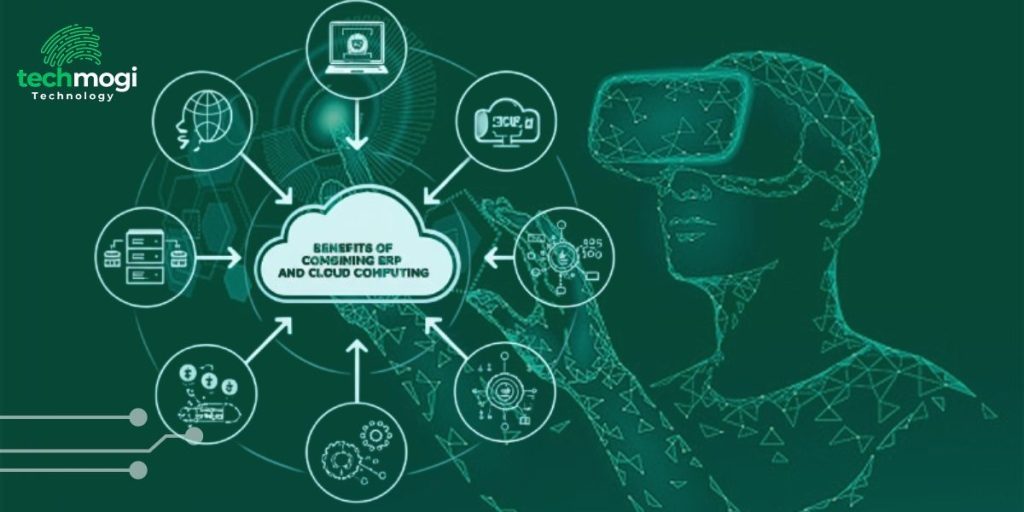Cloud-based solutions are becoming more and more popular among businesses that aim at streamlining their activity. This is one of the solutions between cloud computing and Enterprise Resource Planning (ERP) systems. Combined, these technologies can provide organizations with highly effective assets to enhance efficiency, scalability, teamwork and overall decision-making. The paper explores how an ERP and cloud computing fit with one another and can give companies huge benefits and a chance to remain competitive in rapidly evolving and rapidly changing environment.
What is ERP?
Definition and Purpose of ERP
Enterprise Resource Planning (ERP) is a suite of integrated applications designed to automate and manage core business processes in real-time. It allows organizations to streamline operations by consolidating business functions such as finance, HR, supply chain management, inventory, and customer relationship management (CRM) into a single system. ERP enables data to flow seamlessly across departments, facilitating accurate and up-to-date information for decision-making.
Key Components of ERP
An ERP system typically consists of several modules, each dedicated to a specific business function:
- Financial Management: Helps businesses manage their financial operations, including accounting, budgeting, and reporting.
- Supply Chain Management: Optimizes the flow of goods and services, from procurement to delivery.
- Human Resource Management: Automates HR tasks such as payroll, recruitment, and employee management.
- Manufacturing and Inventory Management: Tracks inventory levels, manages production schedules, and ensures product availability.
- Customer Relationship Management (CRM): Facilitates customer interactions, ensuring better sales, service, and support.
The purpose of ERP is to break down silos in an organization by integrating all business processes into a single system, enhancing visibility and collaboration.
What is Cloud Computing?
Definition and Key Characteristics
Cloud computing is the delivery of computing resources (such as servers, storage, databases, networking, software, and more) over the internet, rather than relying on local servers or personal computers. Cloud services are provided by third-party vendors who maintain the infrastructure, security, and operations, allowing businesses to access these services on-demand without managing the underlying hardware.
Key characteristics of cloud computing include:
- Scalability: Cloud resources can be scaled up or down based on business needs.
- Cost Efficiency: Pay-as-you-go model eliminates the need for significant upfront investment in hardware and IT infrastructure.
- Flexibility: Cloud computing supports remote access, allowing employees to work from anywhere with an internet connection.
- Security: Cloud providers typically offer high levels of security, including encryption, access controls, and compliance with global standards.
Types of Cloud Computing Models
Cloud computing is typically categorized into three models:
- Infrastructure as a Service (IaaS): Provides virtualized computing resources, including servers, storage, and networking.
- Platform as a Service (PaaS): Offers tools and services for developing applications without the need to manage the underlying infrastructure.
- Software as a Service (SaaS): Provides access to software applications via the cloud. ERP systems often fall into this category, with popular providers like Oracle NetSuite and SAP S/4HANA offering cloud-based ERP solutions.
The Benefits of Combining ERP and Cloud Computing

1. Cost Efficiency
The main advantage of ERP and cloud computing integration is associated with the decreased expenses. Legacy on-premise ERP systems are very costly in terms of infrastructure, hardware and IT support personnel. Businesses are able to switch to a subscription-pay model, paying only what they use with cloud ERP. This removes the risk of having to invest heavily upfront, and minimises maintenance costs, since infrastructure, security and upgrades are handled by cloud vendors.
In addition, ERP and Cloud Computing solutions provide organizations with a relatively cheaper TCO in contrast to ERP systems installed in the corporate premises. This is particularly favorable to the small and mid-sized businesses (SMBs) which may not be able to foot the cost of expansive IT infrastructures.
2. Scalability and Flexibility
The use of the cloud has offered scalability opportunities where a business can easily scale up its operations. As an example, a company is able to easily increase its number of users, storage or/and specific ERP modules that might be necessary without having to upgrade its hardware with expensive costs and implementation delays. This degree of flexibility empowers businesses to respond to the dynamic market conditions and customer demands.
In contrast to on-premise ERP and Cloud Computing, which is constrained by the capacity of the local environment, cloud ERP can be dynamically scaled to align with any business demands as and when required, thus resource capacity is always adjusted to any existing operational needs.
3. Remote accessibility and collaboration
Cloud ERP systems support remote access that is crucial to the distributed workforces of today. The system allows employees to access it anywhere, during any time and with any device as long as they are internet enabled. This will make it possible to assure that teams will still be able to collaborate and make decisions on the real-time despite their geographical positions.
The collaboration is also improved by centralized data and communication tools in Cloud ERP. This is especially helpful to global companies with departments in distinct locations as it makes sure that they are all dealing with latest information.
4. Real-Time Data and Analytics
Cloud ERP has one of the strongest capabilities of giving real-time information and analytics. Cloud-based systems allow businesses to know up-to-the-minute data on inventory and even financial information and sales performances. This makes it possible to perform better forecasting and better decision-making.
Projects The best ERP and Cloud Computing software systems come with sophisticated analytics and reports that can be used to monitor KPIs, track trends, and prepare reports on-demand. These functionalities assist businesses in locating areas that can be improved, streamline operations and make informed decisions.
5. Automatic Updates and Maintenance
A typical on-premise ERP system has software, security patches, and system maintenance as some of the aspects that businesses have to take ownership of in ensuring compatibility. This will be time consuming and expensive, especially to the smaller companies that may not be well endowed to undertake them.
Cloud-based ERP systems instead are automatically updated using the cloud provider. This is done to ensure that businesses have updated features, security patches, and improvements at all times without the need of the manual effort. Most maintenance work would be done by the Cloud providers taking some of the load off any internal IT support staff and making sure the systems are performing at an optimal level.
6. Security and Compliance
Cloud providers go to great lengths as far as security is concerned and they have in place solid features like encryption, firewalls, controls, or even multi-factor authentication. MostERP and Cloud Computing vendors can check international data protection regulations like GDPR and HIPAA as well, meaning businesses do not have to worry about adherence to these regulations.
In addition, cloud ERP systems receive updates and patches that enhance security and eliminate the likelihoods of exploits and information leaks because the supplier takes care of any security updates and maintenance. This security is frequently more so than what a business can installed itself with an on premise system.
Challenges in Adopting Cloud ERP
ERP and Cloud Computing has many advantages, but it also has challenges that must be taken into account when overcoming the competition using the on-premise systems.
1. Security Concerns with data
Although the security measures offered by cloud providers is robust, this does not deter the businesses and they are still worried about whether their data is secure in the cloud. The concern of the companies is that the data stored in their cloud contains sensitive information about their customers and putting such information on the cloud subject them to the vulnerability of cyber-attacks or breach of information.
Nevertheless, the risk can largely be reduced through the use of advanced encryption and compliance certifications provided by the cloud providers; businesses may also apply such security measures as data backup and multi-factor authentication to eliminate them.
2. Customization and Vendor Lock-In
Certain businesses might feel that cloud ERP systems will not allow them to achieve their requirements, especially in customization. Although most cloud ERP vendors provide customization options, other organizations might consider the degree of flexibility these solutions offer to be less than what is provided by on-premise ERP systems.
Vendor lock-in is another possible impediment. Companies that adopt the ERP and Cloud Computing solution provided by one vendor run the risk of having issues in case they want to switch vendors in future. It can be complex to port data from one cloud system to another, thus businesses need to select cloud ERP providers carefully to be sure the system can support its long-term needs.
3. Data Migration
Migrating data from an on-premise ERP system to a cloud-based solution can be a complex process. It requires careful planning, data cleansing, and testing to ensure that all business data is transferred accurately and without disruption. Businesses may need to invest in third-party consultants or IT resources to facilitate the migration.
Read More : What is cloud computing?
Comparing Cloud ERP vs. On-Premise ERP
Cost Comparison
| Feature | Cloud ERP | On-Premise ERP |
| Initial Investment | Lower (subscription-based) | Higher (hardware, installation) |
| Maintenance Costs | Included in subscription | Ongoing internal IT staff costs |
| Scalability | Easily scalable | Limited by infrastructure |
| Updates | Automatic updates | Manual updates |
Accessibility and Mobility
| Feature | Cloud ERP | On-Premise ERP |
| Remote Access | Yes | No (limited to physical location) |
| Collaboration Tools | Built-in collaboration tools | Must be integrated separately |
| Mobility for Employees | Highly mobile and accessible | Restricted to office premises |
Control and Customization
| Feature | Cloud ERP | On-Premise ERP |
| Control Over Data | Vendor-controlled | Full internal control |
| Customization Options | Limited to vendor capabilities | High degree of customization |
Conclusion
Hosted ERP systems are a changing direction in the way companies are running their resources and functions. With the benefits of cost saving, flexibility, remote accessibility and real-time information, ERP and Cloud Computing has transformed the way organizations streamline their operations, and make decisions. When adopting cloud ERP system, a business will have to pay close attention to issues that may arise like security of information stored on cloud, lack of customization and problems with migration.
As cloud computing is advancing, organizations which adopt these technologies will be better placed to face the dynamic nature of businesses today and keep a competitive advantage. As a small business just starting out in the industry or a large company with already established operations, integration of cloud ERP into your operations can become a game changer to boost efficiency, collaboration and decision-making at the organizational level.
FAQs
What is ERP and how does it benefit businesses?
ERP (Enterprise Resource Planning) integrates core business functions like finance, supply chain, and HR, enhancing efficiency, data flow, and decision-making.
How does cloud computing enhance ERP systems?
Cloud computing offers scalability, remote access, real-time data, and reduced costs, making ERP systems more efficient and accessible for businesses.
What are the cost benefits of cloud-based ERP?
Cloud-based ERP reduces upfront costs, eliminates the need for on-premise hardware, and offers a subscription-based pricing model, making it cost-effective for businesses.
What challenges should businesses consider when adopting cloud ERP?
Businesses should evaluate potential data security concerns, customization limitations, migration complexities, and vendor lock-in before adopting cloud ERP solutions.
How does cloud ERP improve collaboration within an organization?
Cloud ERP allows employees to access real-time data from any location, facilitating seamless collaboration across departments, improving decision-making and efficiency.

Hi, I’m Ethan Cole, the writer behind techmogi.com. I cover tech topics like how-to guides, digital tools, social media tips, and everyday tech fixes. I enjoy breaking down complex information into simple, useful content that anyone can understand. If you’re looking for clear, no-nonsense tech advice, you’ll feel right at home here.